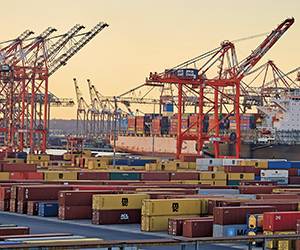Propane Holds the Key to Reliable, Efficient Electric Port Tractor Recharging
Oct 16, 2024

Propane puts port operators in control of EV charging and avoids grid-power headaches
It may seem a bit of a paradox that propane is crucial to charging electric terminal tractors at both seaports and inland ports, but it is, because the proliferation of these vehicles is requiring substantial power needs that might not be fulfilled by the current electrical grid.
This becomes a problem when ports are being mandated to move to partial or even full electrification of terminal tractors and other equipment, in a bid to substantially reduce emissions. Put simply, the grid may not be able to keep up with the power demand, and it can be cost-prohibitive and logistically challenging to run more power from the grid to a port. In some cases, it cannot be done.
The obvious fallback position is generators, but diesel generators introduce comparable emissions into the atmosphere as the diesel terminal tractors that electric models are replacing. Propane generators solve that problem with a reliable, clean and available energy source with technology that can be easily relocated, ensuring terminal tractors keep moving.
Power to the Port
According to Scott Bradley, director of sales and strategic partnerships at Pioneer eMobility, which offers the propane-powered e-Boost POD and e-Boost Mobile generators, there just isn’t enough grid power to go around at a port to adequately charge hundreds or even thousands of terminal tractors.
“It’s getting the power to the port,” Bradley said. “Terminal tractors will use 100,000 kWh of energy a year. Ports aren’t keen to rip up their land to put in cabling. And who’s doing this – the port authority? Terminal operators? Logistics providers?”
Diesel and electric terminal tractors are very similar; they occupy the same footprint and can move the same weights. The big difference, of course, is that diesel technology spews harmful emissions into the air, like particulate matter, sulfur oxides and nitrogen oxides. This negatively impacts anyone working onsite at a port, and the residents of nearby communities.
Electric terminal tractor technology produces no emissions and as batteries have improved in recent years, they are getting longer run times with charge times that are steadily improving as battery voltage increases. It used to take up to 10 hours to recharge an electric terminal tractor; now, it only takes a couple of hours to get the battery to 70%.
Keeping terminal tractors up and running is crucial because if electric models are down for long periods of time due to recharging, the port risks fines for inability to stay on schedule for ship unloading. But that’s risky without generators because grid power often can’t be used to recharge electric tractors at peak hours, if grid power is even available.
Propane generators like the Level 3 (90-350 kW) e-Boost POD and e-Boost Mobile solve a lot of problems. In essence, ports can recharge their electric terminal tractors whenever they need to, even at peak electric grid periods. In other words, for the first time, ports have control of their charging strategy while simultaneously adhering to emissions mandates, whether they are internal goals or state requirements.
Here’s another problem propane generators solve: if a diesel fuel tank leaks, it can contaminate both the soil and water. Propane doesn’t do that; it is a nontoxic fuel and on the off-chance that there is a leak, the propane fuel will boil off and reenter the atmosphere.
In Control of Power Needs
Propane generators need to be refueled in order to keep electric terminal tractors moving. The fuel itself is provided by a local or regional propane provider, and like diesel generators, the fuel is stored in tanks onsite at a port. The advantage of propane is that, once again, the port is in control of its propane refueling needs. Propane providers can refill the tanks once per day, or once per week, depending on needs. Plus, it can be scaled out as an operation grows more robust.
Another advantage of propane generators, Bradley said, is their portability, or ability to move them around to where the power is needed most, whether that’s for electric terminal tractors or other needs, like electric vehicles coming off ships or even out of buildings. “Mobility is something that’s important at ports,” he said. “When they are not certain where they want to charge these vehicles, terminal tractors and drayage vehicles, a mobile solution makes a lot of sense.”
An understated benefit of electric terminal tractors is that they are much quieter than diesel models. In order to achieve that benefit, there has to be a reliable fuel source, especially as operations ramp up. No matter where a port is located, terminal tractors are constantly moving, with many putting up tens of thousands of miles. That’s to be expected when a port operates 24 hours a day.
With the push in some states to achieve zero or near-zero greenhouse gas emissions at ports, electric terminal tractors will lead the way, with the help of propane-powered generators. In growing circumstances, that also includes renewable propane and renewable propane blends, which are chemically the same as conventional propane but even lower emissions.
Learn more about propane power generation.

Green Ports